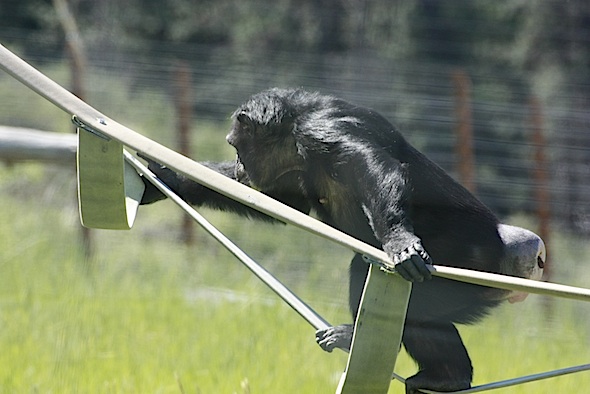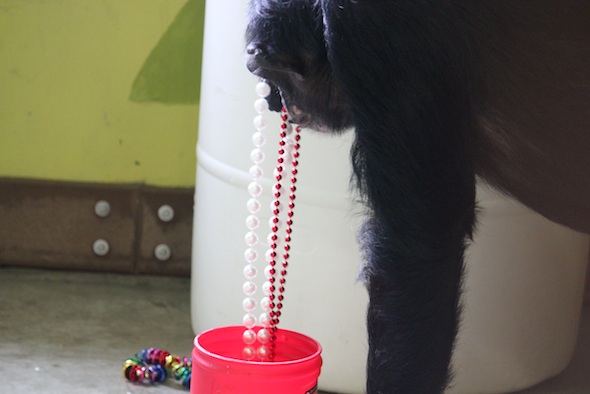One of our goals as a sanctuary is to give the chimps as much independence and autonomy as we can, given the inherent limitations of captivity. So we’re thrilled to see them finding their own food on Young’s Hill. Right now, their favorites include grass, dandelion leaves, and prickly lettuce. There are two bamboo groves on the hill, but the chimps haven’t taken much of an interest in eating them as of yet (climbing them is a different story). Of course, none of this will take the place of the meals we serve throughout the day, but it’s nice that the chimps can head out and grab a light snack whenever they want.
Archives for June 2012
Violence
Recently, an infant chimpanzee at the L.A. Zoo was killed by an adult member of the troop in full view of zoo visitors. A few days later, a student volunteering at the Chimp Eden sanctuary in South Africa was pulled into an enclosure and attacked by two adult male chimpanzees. Both incidents served as startling reminders of the capacity for violence in our closest relatives and have left many people wondering what makes chimpanzees commit such severe acts of aggression.
Unfortunately, while incidents like these are rare, they are not abnormal. Put simply, violence is a fact of life in chimpanzee society. While males typically grab all the attention with their aggressive dominance struggles and their lethal intergroup raids, females also kill on occasion, with infants and other adult females being their most likely victims. In chimpanzee communities, severe aggression can be a means to reduce or prevent resource competition. This can result in the killing of members of other communities, as well as immigrant females and even infants within the troop. In some cases, the killing of an infant can increase mating opportunities for males. For instance, if a female gives birth, she will not enter estrus for another four to five years while she nurses and raises her new child. If that child dies, however, she will quickly become receptive again. Thus, there can be an incentive for a male who is not the parent to kill the infant so that he can mate with the mother (this is one reason primatologists believe that females may try to confuse paternity).
Violent behavior can serve many functions in chimpanzee society. What functions did these incidents at the L.A. Zoo and Chimp Eden serve? Honestly, we don’t know. It’s much easier to offer an evolutionary explanation for why violence exists in general than it is to explain specific acts.
As caregivers for captive chimpanzees, we witness aggressive behavior on a daily basis. Sometimes the motivation behind it is clear; other times we are left scratching our heads. The way I think about it is this: evolution has endowed chimpanzees with certain tendencies for aggressive behavior, but it does not control how those tendencies are applied. Aggression towards non-group members in the wild can help chimpanzees defend territory and the resources located therein. But that same aggressive tendency can also result in an attack on the very people trying to care for them in captivity.
All we really know is that violence in chimpanzees is not an aberration, nor is it all they are capable of. In fact, one of the reasons why we might be uncomfortable with chimpanzee violence is that it hits a little too close to home. To be sure, aggression in chimpanzees is shocking in its sheer physicality – teeth and fists instead of knives and guns. But even though chimpanzees exhibit higher rates of aggression overall, rates of lethal violence in chimpanzees are similar to those in some human societies. In some ways, we are more alike than we’d like to believe.
Fourth of July party planning
This year will be the fifth 4th of July party the chimps will have had, but the first since Young’s Hill was opened! I’m excited to have another summer party with open air for the chimps. (The last one was Negra’s birthday a couple weeks ago). Check out these past blog posts with photos and video from previous 4th of July parties: 2008, 2009, 2010, and 2011.
As we were trying to come up with some ideas about what to do for this party, I thought it might be nice to hear some suggestions from our blog readers. Note: the restrictions on diet include no animal products, no added sugar, and limited added salt. They love fresh produce so we were thinking of including red, white, and blue produce items. Of course the traditional watermelon and corn on the cob will be included, plus we’ll make some Field Roast hot dogs for the chimps. Another idea might be cutting an orange in half and freezing juice in it to make a fun frozen treat. For enrichment we were thinking we might make some piñatas and of course red, white, and blue items. Any other ideas? Please comment here! And if you’re interested in helping sponsor the party, find out how you can contribute here.
Annie with a mouth full of corn:
Jamie’s adventures on the hill
Inspiration
I often use things I’ve seen the chimps do as inspiration to help me come up with enrichment themes. Annie seems to really like beaded necklaces. I often see her playing with them– swishing them around in her hands, using them to play tug of war with her friends, or shoving a bunch in her mouth, filling up with water, and sucking all the water out:
So, today I decided to make it easier for her, and everyone. I took containers, filled them with beaded necklaces and then filled them with water. The chimps must have been inspired because almost everyone spent some time playing with the necklaces. It seems it’s no longer just Annie that thinks water-filled beaded necklaces are fun.
Imposter
Close friends
It’s so relaxing to watch the chimps groom one another. Grooming is often used as a way to, not only help clean up your friends, but also to strengthen bonds and friendships. Foxie and Burrito have a pretty close friendship and I caught them in the middle of a very sweet grooming session this afternoon.





















